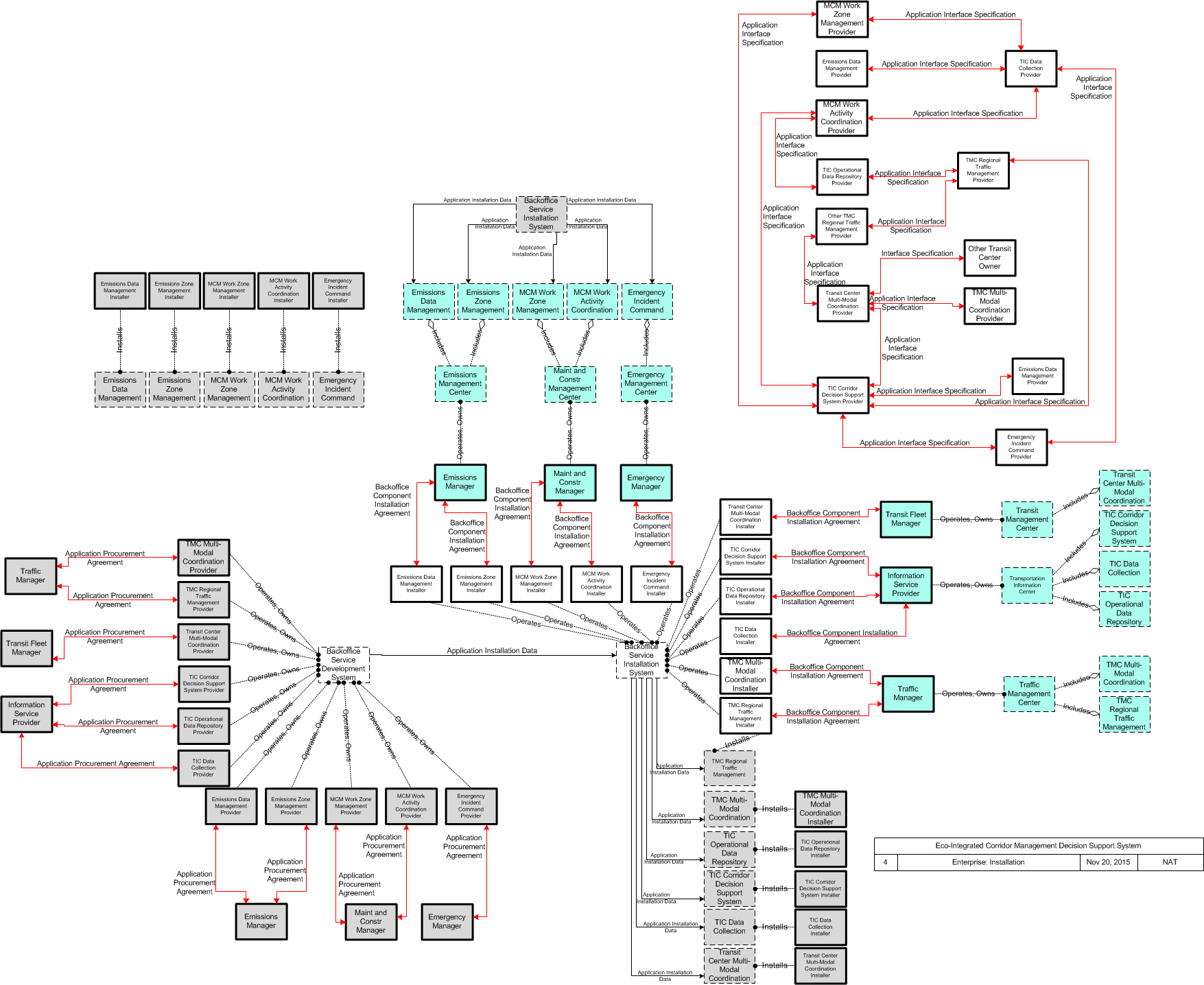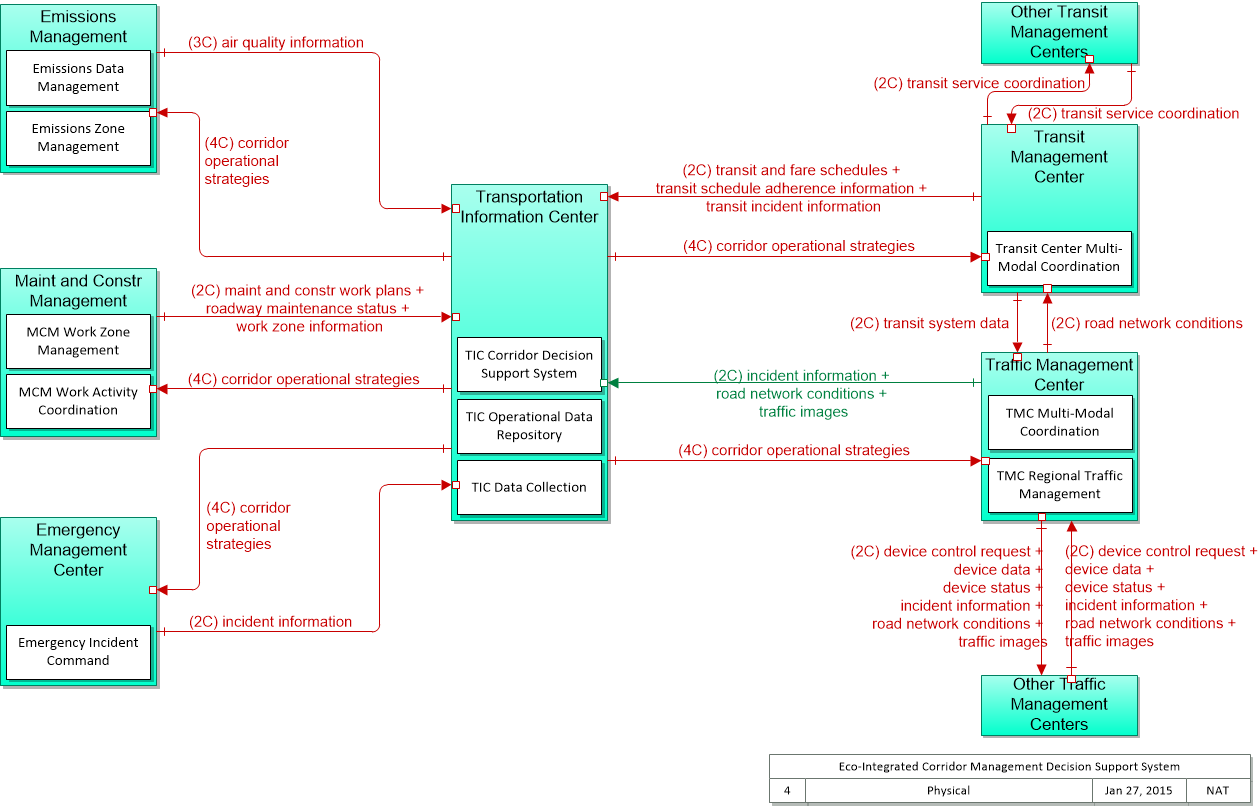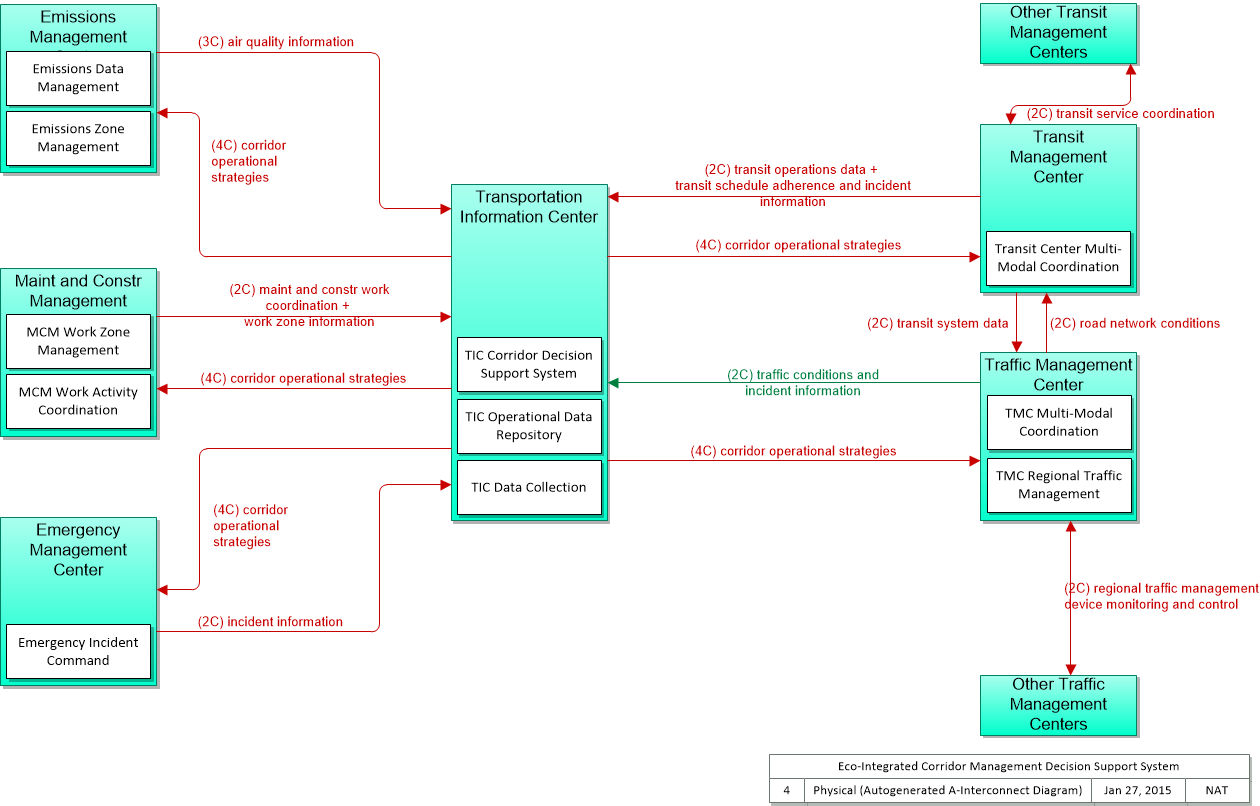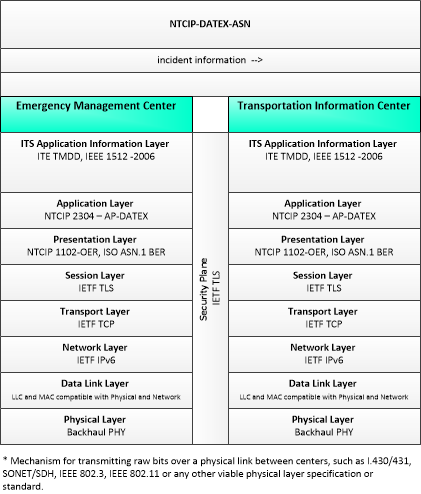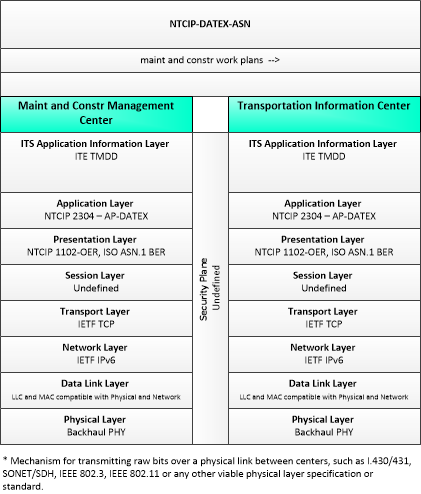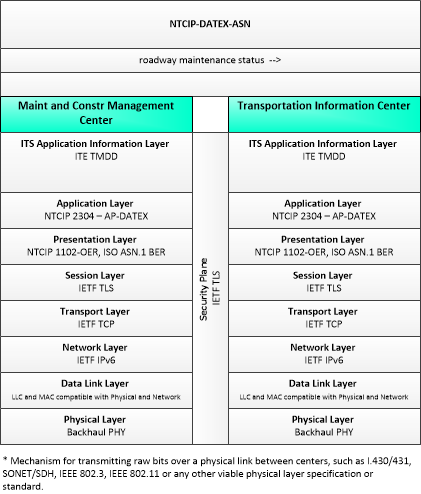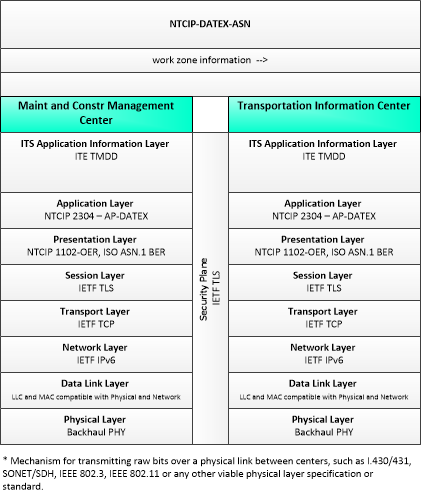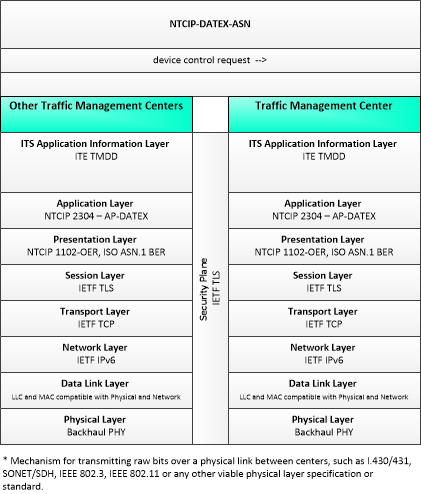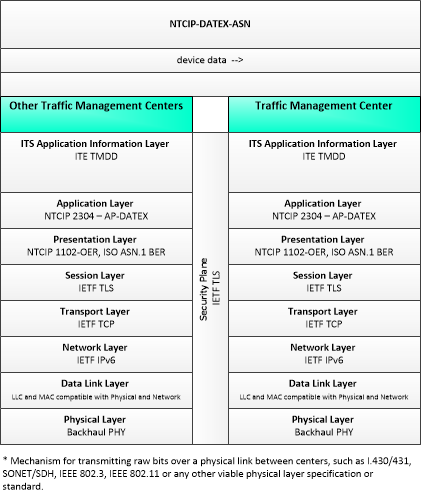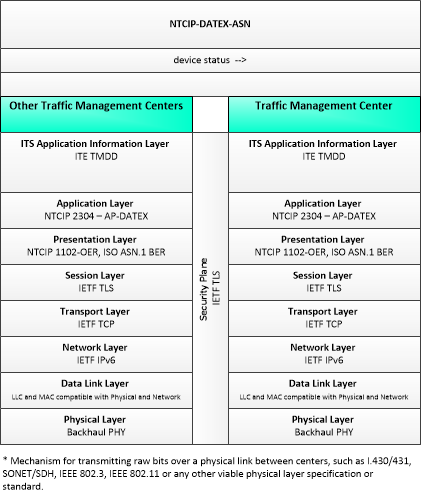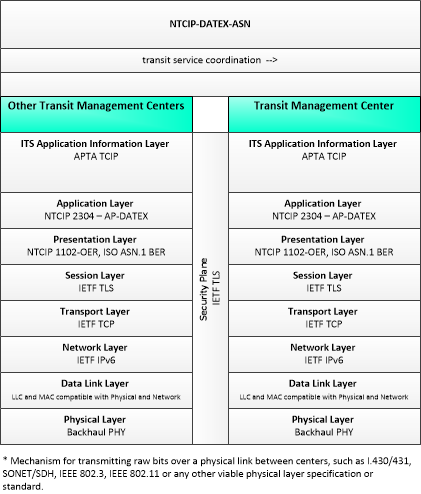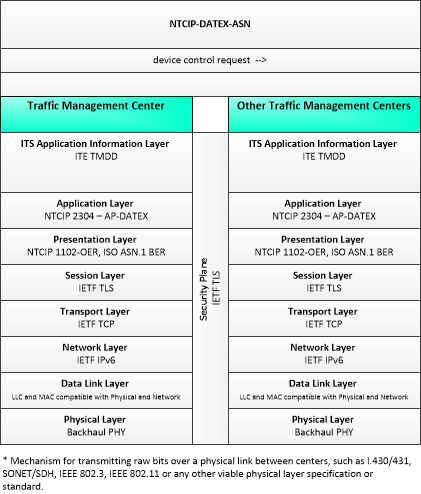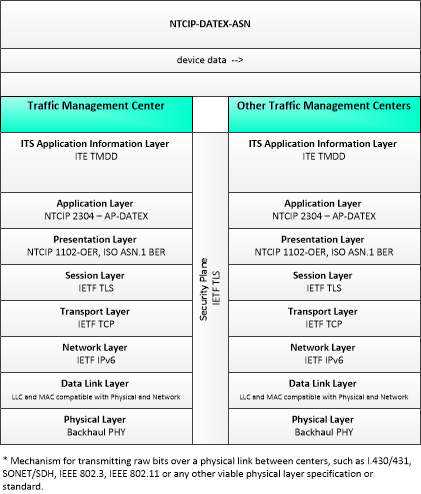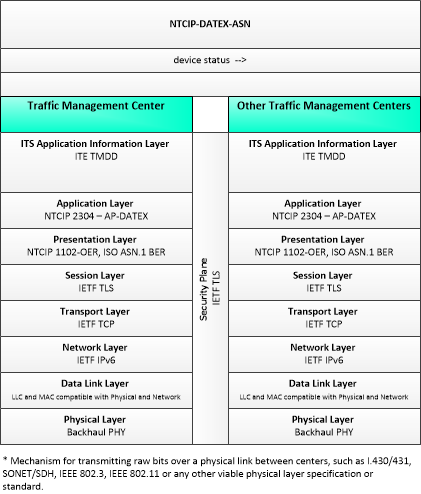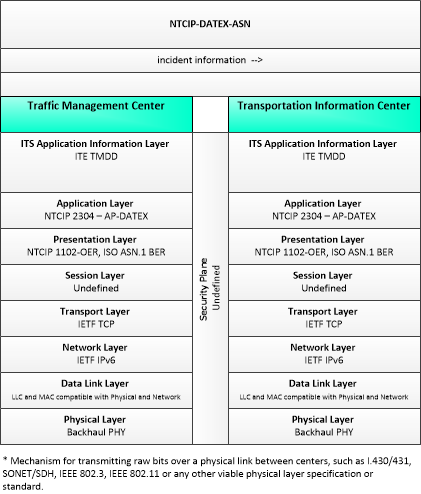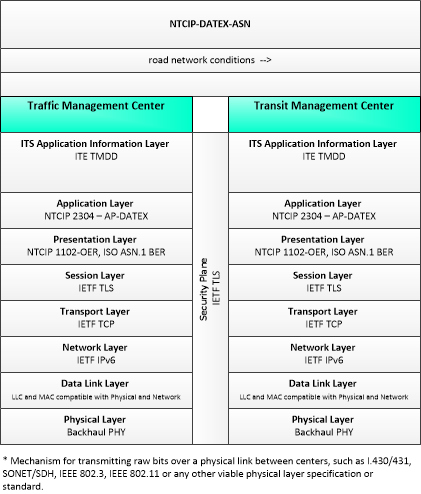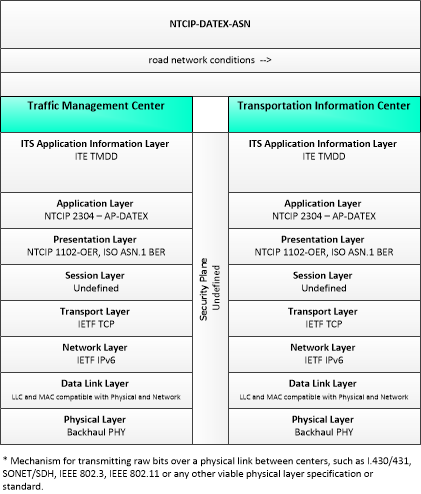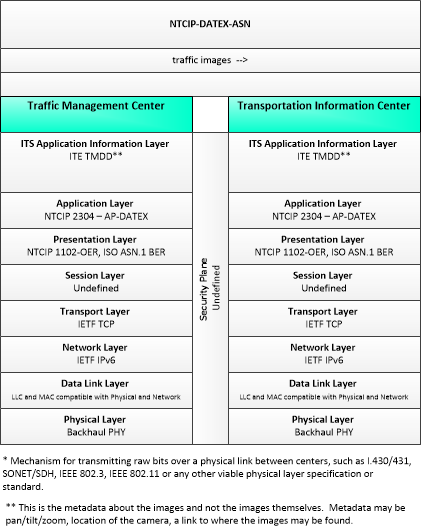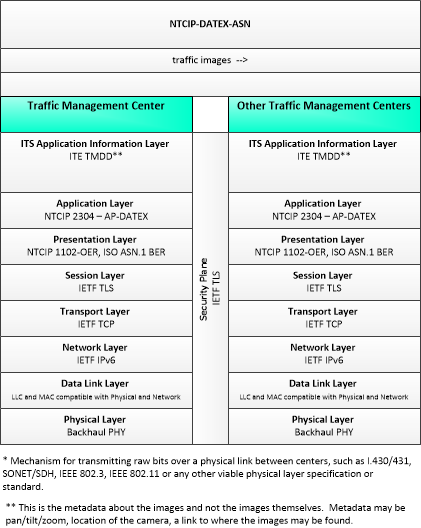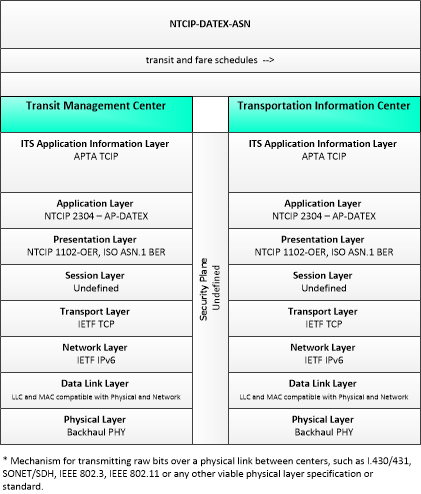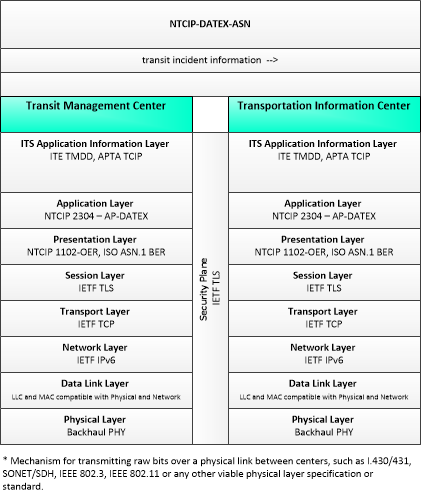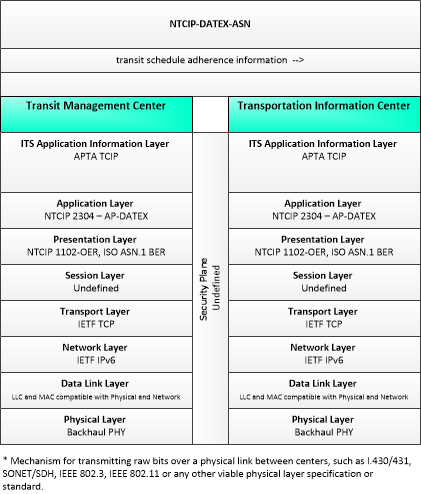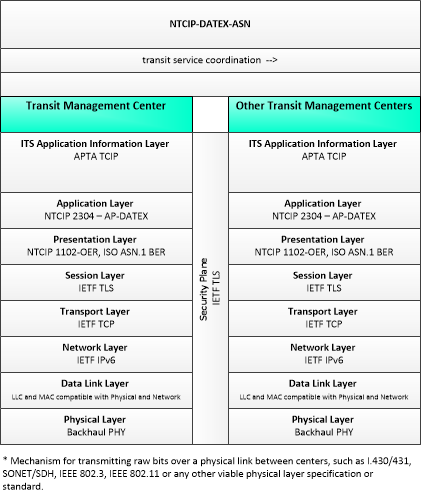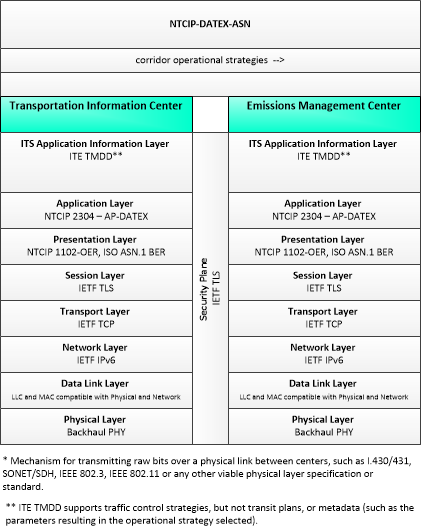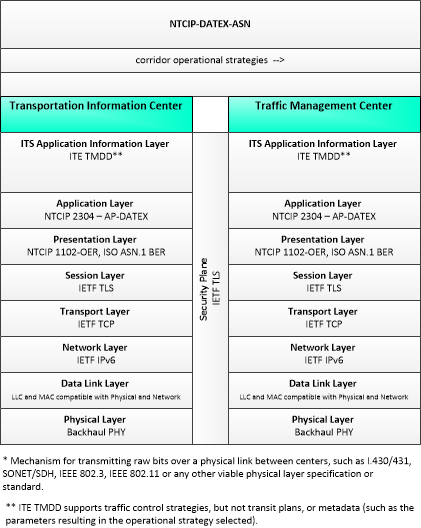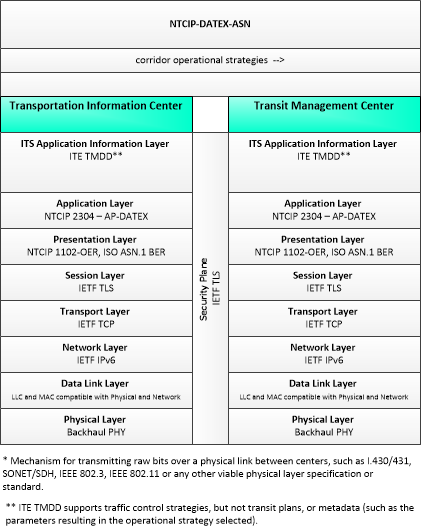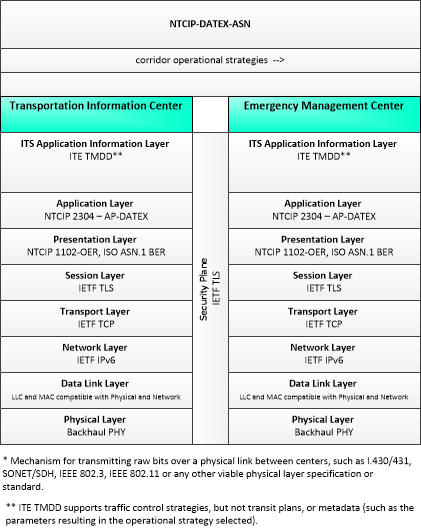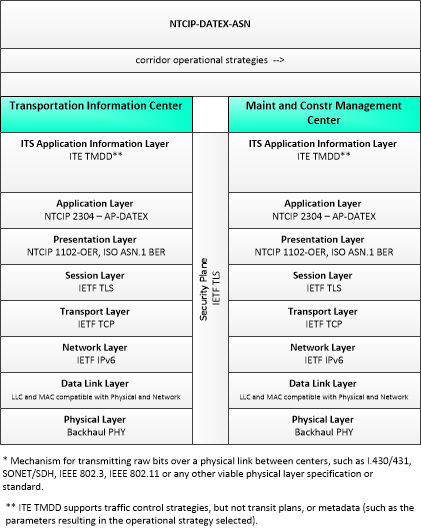Type: Environmental
Groups:- AERIS/ Sustainable Travel
Eco-Integrated Corridor Management Decision Support System
The Eco-Integrated Corridor Management Decision Support System application uses historical, real-time, and predictive traffic and environmental data on arterials, freeways, and transit systems to determine operational decisions that are environmentally beneficial to the corridor. The Eco-Integrated Corridor Management (Eco-ICM) Decision Support System is a data-fusion system that collects information from various multimodal systems. Data from these systems is then used to determine operational strategies for arterials, freeways, and transit that minimize the environment impact of the corridor. For example, on a code red air quality day, the Eco-ICM Decision Support System may recommend eco-signal timing plans, eco-ramp metering strategies, eco-speed limits, and recommendations for increased transit service.
Enterprise
SVG Diagrams: Installation Operations Maintenance Certification
PNG Diagrams: Installation Operations Maintenance Certification

Business Interaction Matrix:
| Eco-Integrated Corridor Management Decision Support System Operations Stage | ||||||||
|---|---|---|---|---|---|---|---|---|
| Other Transit Center Owner | Traffic Manager | Emissions Manager | Information Service Provider | Maint and Constr Manager | Other Traffic Manager | Emergency Manager | Transit Fleet Manager | |
| Other Transit Center Owner | Service Coordination Agreement | |||||||
| Traffic Manager | Information Exchange and Action Agreement | Information Exchange Agreement | Information Exchange Agreement | |||||
| Emissions Manager | Information Exchange and Action Agreement | |||||||
| Information Service Provider | Information Exchange and Action Agreement | Information Exchange and Action Agreement | Information Exchange and Action Agreement | Information Exchange and Action Agreement | Information Exchange and Action Agreement | |||
| Maint and Constr Manager | Information Exchange and Action Agreement | |||||||
| Other Traffic Manager | Information Exchange Agreement | |||||||
| Emergency Manager | Information Exchange and Action Agreement | |||||||
| Transit Fleet Manager | Service Coordination Agreement | Information Exchange Agreement | Information Exchange and Action Agreement | |||||
Includes Enterprise Objects:
| Enterprise Object | Description |
|---|---|
| Application Certification Entity | The body that determines whether an application may be deployed and operated in the Connected Vehicle Environment. This entity's composition, the requirements it applies and the procedures it uses to verify those requirements may vary with application type. For example, applications with human safety component (crash avoidance, movement assistance etc.) may have stringent requirements and extensive testing in a variety of conditions, while applications that provide strictly mobility functionality may have far less testing requirements; possibly as little as just making sure the application doesn't interfere with any other applications. |
| Emergency Incident Command Installer | Application Component Installers are specified more by role than by function. Installers are responsible for the installation of the application component, which may require a support system, and may entail agreements and relationships between end users and application providers. |
| Emergency Incident Command Maintainer | Application Component Maintainers are specified more by role than by function. Maintainers are responsible for the maintenance (configuration changes, patches and updates, hardware repairs) of the application component, which may require a support system, and may entail agreements and relationships between end users and application providers. |
| Emergency Incident Command Provider | Application Component Providers are specified more by role than by function. Providers are responsible for the development of the application component, including initial creation, enhancement and bug fixes. Delivery of the application to the end user may require relationships with other entities (installers, maintainers) if the provider chooses not to fulfill those roles. |
| Emergency Manager | The "Emergency Manager" represents agencies charged with incident management, disaster response, and transportation environment security. |
| Emissions Data Management Installer | Application Component Installers are specified more by role than by function. Installers are responsible for the installation of the application component, which may require a support system, and may entail agreements and relationships between end users and application providers. |
| Emissions Data Management Maintainer | Application Component Maintainers are specified more by role than by function. Maintainers are responsible for the maintenance (configuration changes, patches and updates, hardware repairs) of the application component, which may require a support system, and may entail agreements and relationships between end users and application providers. |
| Emissions Data Management Provider | Application Component Providers are specified more by role than by function. Providers are responsible for the development of the application component, including initial creation, enhancement and bug fixes. Delivery of the application to the end user may require relationships with other entities (installers, maintainers) if the provider chooses not to fulfill those roles. |
| Emissions Manager | The entity responsible for the monitoring of and reaction to emissions. |
| Emissions Zone Management Installer | Application Component Installers are specified more by role than by function. Installers are responsible for the installation of the application component, which may require a support system, and may entail agreements and relationships between end users and application providers. |
| Emissions Zone Management Maintainer | Application Component Maintainers are specified more by role than by function. Maintainers are responsible for the maintenance (configuration changes, patches and updates, hardware repairs) of the application component, which may require a support system, and may entail agreements and relationships between end users and application providers. |
| Emissions Zone Management Provider | Application Component Providers are specified more by role than by function. Providers are responsible for the development of the application component, including initial creation, enhancement and bug fixes. Delivery of the application to the end user may require relationships with other entities (installers, maintainers) if the provider chooses not to fulfill those roles. |
| Federal Regulatory | Federal regulatory bodies that have legal authority to control and/or provide input to policies regulating transportation infrastructure and operations. This includes entities such as the Federal Communications Commission and US Department of Transportation. |
| Information Service Provider | The "Information Service Provider" represents the owner of the Transportation Information Center. The Information Service Provider is responsible for collecting and disseminating information relevant to the traveling public. |
| Maint and Constr Manager | The organization responsible for maintenance and construction activities. |
| MCM Work Activity Coordination Installer | Application Component Installers are specified more by role than by function. Installers are responsible for the installation of the application component, which may require a support system, and may entail agreements and relationships between end users and application providers. |
| MCM Work Activity Coordination Maintainer | Application Component Maintainers are specified more by role than by function. Maintainers are responsible for the maintenance (configuration changes, patches and updates, hardware repairs) of the application component, which may require a support system, and may entail agreements and relationships between end users and application providers. |
| MCM Work Activity Coordination Provider | Application Component Providers are specified more by role than by function. Providers are responsible for the development of the application component, including initial creation, enhancement and bug fixes. Delivery of the application to the end user may require relationships with other entities (installers, maintainers) if the provider chooses not to fulfill those roles. |
| MCM Work Zone Management Installer | Application Component Installers are specified more by role than by function. Installers are responsible for the installation of the application component, which may require a support system, and may entail agreements and relationships between end users and application providers. |
| MCM Work Zone Management Maintainer | Application Component Maintainers are specified more by role than by function. Maintainers are responsible for the maintenance (configuration changes, patches and updates, hardware repairs) of the application component, which may require a support system, and may entail agreements and relationships between end users and application providers. |
| MCM Work Zone Management Provider | Application Component Providers are specified more by role than by function. Providers are responsible for the development of the application component, including initial creation, enhancement and bug fixes. Delivery of the application to the end user may require relationships with other entities (installers, maintainers) if the provider chooses not to fulfill those roles. |
| Other TMC Regional Traffic Management Provider | Application Component Providers are specified more by role than by function. Providers are responsible for the development of the application component, including initial creation, enhancement and bug fixes. Delivery of the application to the end user may require relationships with other entities (installers, maintainers) if the provider chooses not to fulfill those roles. |
| Other Traffic Manager | Representing another Traffic Manager, "Other Traffic Manager" provides the source and destination for agreements and expectations between Traffic Managers, enabling traffic management activities to be coordinated across jurisdictional boundaries. |
| Other Transit Center Owner | The owner of another transit system. This object provides source and destination for flows and relationships between transit system owners. |
| State Regulatory | State regulatory bodies that have legal authority to control and/or provide input to policies regulating vehicles, transportation infrastructure and operations. This includes entities like Departments of Motor Vehicles, property tax authorities and tolling agencies. |
| TIC Corridor Decision Support System Installer | Application Component Installers are specified more by role than by function. Installers are responsible for the installation of the application component, which may require a support system, and may entail agreements and relationships between end users and application providers. |
| TIC Corridor Decision Support System Maintainer | Application Component Maintainers are specified more by role than by function. Maintainers are responsible for the maintenance (configuration changes, patches and updates, hardware repairs) of the application component, which may require a support system, and may entail agreements and relationships between end users and application providers. |
| TIC Corridor Decision Support System Provider | Application Component Providers are specified more by role than by function. Providers are responsible for the development of the application component, including initial creation, enhancement and bug fixes. Delivery of the application to the end user may require relationships with other entities (installers, maintainers) if the provider chooses not to fulfill those roles. |
| TIC Data Collection Installer | Application Component Installers are specified more by role than by function. Installers are responsible for the installation of the application component, which may require a support system, and may entail agreements and relationships between end users and application providers. |
| TIC Data Collection Maintainer | Application Component Maintainers are specified more by role than by function. Maintainers are responsible for the maintenance (configuration changes, patches and updates, hardware repairs) of the application component, which may require a support system, and may entail agreements and relationships between end users and application providers. |
| TIC Data Collection Provider | Application Component Providers are specified more by role than by function. Providers are responsible for the development of the application component, including initial creation, enhancement and bug fixes. Delivery of the application to the end user may require relationships with other entities (installers, maintainers) if the provider chooses not to fulfill those roles. |
| TIC Operational Data Repository Installer | Application Component Installers are specified more by role than by function. Installers are responsible for the installation of the application component, which may require a support system, and may entail agreements and relationships between end users and application providers. |
| TIC Operational Data Repository Maintainer | Application Component Maintainers are specified more by role than by function. Maintainers are responsible for the maintenance (configuration changes, patches and updates, hardware repairs) of the application component, which may require a support system, and may entail agreements and relationships between end users and application providers. |
| TIC Operational Data Repository Provider | Application Component Providers are specified more by role than by function. Providers are responsible for the development of the application component, including initial creation, enhancement and bug fixes. Delivery of the application to the end user may require relationships with other entities (installers, maintainers) if the provider chooses not to fulfill those roles. |
| TMC Multi-Modal Coordination Installer | Application Component Installers are specified more by role than by function. Installers are responsible for the installation of the application component, which may require a support system, and may entail agreements and relationships between end users and application providers. |
| TMC Multi-Modal Coordination Maintainer | Application Component Maintainers are specified more by role than by function. Maintainers are responsible for the maintenance (configuration changes, patches and updates, hardware repairs) of the application component, which may require a support system, and may entail agreements and relationships between end users and application providers. |
| TMC Multi-Modal Coordination Provider | Application Component Providers are specified more by role than by function. Providers are responsible for the development of the application component, including initial creation, enhancement and bug fixes. Delivery of the application to the end user may require relationships with other entities (installers, maintainers) if the provider chooses not to fulfill those roles. |
| TMC Regional Traffic Management Installer | Application Component Installers are specified more by role than by function. Installers are responsible for the installation of the application component, which may require a support system, and may entail agreements and relationships between end users and application providers. |
| TMC Regional Traffic Management Maintainer | Application Component Maintainers are specified more by role than by function. Maintainers are responsible for the maintenance (configuration changes, patches and updates, hardware repairs) of the application component, which may require a support system, and may entail agreements and relationships between end users and application providers. |
| TMC Regional Traffic Management Provider | Application Component Providers are specified more by role than by function. Providers are responsible for the development of the application component, including initial creation, enhancement and bug fixes. Delivery of the application to the end user may require relationships with other entities (installers, maintainers) if the provider chooses not to fulfill those roles. |
| Traffic Manager | The entity responsible for the management of traffic, both freeway and arterial. |
| Transit Center Multi-Modal Coordination Installer | Application Component Installers are specified more by role than by function. Installers are responsible for the installation of the application component, which may require a support system, and may entail agreements and relationships between end users and application providers. |
| Transit Center Multi-Modal Coordination Maintainer | Application Component Maintainers are specified more by role than by function. Maintainers are responsible for the maintenance (configuration changes, patches and updates, hardware repairs) of the application component, which may require a support system, and may entail agreements and relationships between end users and application providers. |
| Transit Center Multi-Modal Coordination Provider | Application Component Providers are specified more by role than by function. Providers are responsible for the development of the application component, including initial creation, enhancement and bug fixes. Delivery of the application to the end user may require relationships with other entities (installers, maintainers) if the provider chooses not to fulfill those roles. |
| Transit Fleet Manager | The agency or organization that operates transit vehicles. This includes administration, routing, driver instruction, maintenance and any other responsibilities associated with the operations and maintenance of a transit system. |
Includes Resources:
| Resource | Description |
|---|---|
| Application Component Certification Requirements | The requirements that define the functionality, performance and operational environment of an application component. Certification Requirements must be met in order for an application to be installed in the CVE. |
| Backoffice Service Development System | The systems used to develop backoffice (center) hardware and software components of applications. |
| Backoffice Service Installation System | The systems used to install and configure backoffice (center) hardware and software components. |
| Backoffice Service Maintenance System | The systems used to maintain and upgrade backoffice (center) hardware and software components. |
| Emergency Incident Command | "Emergency Incident Command" provides tactical decision support, resource coordination, and communications integration for Incident Commands that are established by first responders at or near the incident scene to support local management of an incident. It supports communications with public safety, emergency management, transportation, and other allied response agency centers, tracks and maintains resource information, action plans, and the incident command organization itself. Information is shared with agency centers including resource deployment status, hazardous material information, traffic, road, and weather conditions, evacuation advice, and other information that enables emergency or maintenance personnel in the field to implement an effective, safe incident response. It supports the functions and interfaces commonly supported by a mobile command center. |
| Emergency Management Center | The 'Emergency Management Center' represents systems that support incident management, disaster response and evacuation, security monitoring, and other security and public safety-oriented ITS applications. It includes the functions associated with fixed and mobile public safety communications centers including public safety call taker and dispatch centers operated by police (including transit police), fire, and emergency medical services. It includes the functions associated with Emergency Operations Centers that are activated at local, regional, state, and federal levels for emergencies and the portable and transportable systems that support Incident Command System operations at an incident. This Center also represents systems associated with towing and recovery, freeway service patrols, HAZMAT response teams, and mayday service providers. It manages sensor and surveillance equipment used to enhance transportation security of the roadway infrastructure (including bridges, tunnels, interchanges, and other key roadway segments) and the public transportation system (including transit vehicles, public areas such as transit stops and stations, facilities such as transit yards, and transit infrastructure such as rail, bridges, tunnels, or bus guideways). It provides security/surveillance services to improve traveler security in public areas not a part of the public transportation system. It monitors alerts, advisories, and other threat information and prepares for and responds to identified emergencies. It coordinates emergency response involving multiple agencies with peer centers. It stores, coordinates, and utilizes emergency response and evacuation plans to facilitate this coordinated response. Emergency situation information including damage assessments, response status, evacuation information, and resource information are shared The Emergency Management Center also provides a focal point for coordination of the emergency and evacuation information that is provided to the traveling public, including wide-area alerts when immediate public notification is warranted. It tracks and manages emergency vehicle fleets using real-time road network status and routing information from the other centers to aid in selecting the emergency vehicle(s) and routes, and works with other relevant centers to tailor traffic control to support emergency vehicle ingress and egress, implementation of special traffic restrictions and closures, evacuation traffic control plans, and other special strategies that adapt the transportation system to better meet the unique demands of an emergency. |
| Emissions Data Management | "Emissions Data Management" collects and stores air quality and vehicle emissions information by remotely monitoring and controlling area wide and point sensors. General air quality measures are distributed as general traveler information and also may be used in demand management programs. Collected roadside emissions are analyzed and used to detect, identify, and notify concerned parties regarding vehicles that exceed emissions standards. |
| Emissions Management Center | The 'Emissions Management Center' provides the capabilities for air quality managers to monitor and manage air quality. These capabilities include collecting emissions data from distributed emissions sensors (included in ITS Roadway Equipment in CVRIA) and directly from connected vehicles. The sensors monitor general air quality and also monitor the emissions of individual vehicles on the roadway. The measures are collected, processed, and used to support environmental monitoring applications. |
| Emissions Zone Management | "Emissions Zone Management" identifies existing and potential emissions hot spots and coordinates with transportation agencies and their systems to establish low emissions zones to manage air quality in these areas. Through this coordination, the geographic boundary, restrictions, and pricing for the low emissions zone are established and adjusted. |
| Maint and Constr Management Center | The 'Maint and Constr Management Center' monitors and manages roadway infrastructure construction and maintenance activities. Representing both public agencies and private contractors that provide these functions, this physical object manages fleets of maintenance, construction, or special service vehicles (e.g., snow and ice control equipment). The physical object receives a wide range of status information from these vehicles and performs vehicle dispatch, routing, and resource management for the vehicle fleets and associated equipment. The physical object participates in incident response by deploying maintenance and construction resources to an incident scene, in coordination with other center physical objects. The physical object manages equipment at the roadside, including environmental sensors and automated systems that monitor and mitigate adverse road and surface weather conditions. It manages the repair and maintenance of both non-ITS and ITS equipment including the traffic controllers, detectors, dynamic message signs, signals, and other equipment associated with the roadway infrastructure. Weather information is collected and fused with other data sources and used to support advanced decision support systems. The physical object remotely monitors and manages ITS capabilities in work zones, gathering, storing, and disseminating work zone information to other systems. It manages traffic in the vicinity of the work zone and advises drivers of work zone status (either directly at the roadside or through an interface with the Transportation Information Center or Traffic Management Center physical objects.) Construction and maintenance activities are tracked and coordinated with other systems, improving the quality and accuracy of information available regarding closures and other roadway construction and maintenance activities. |
| MCM Work Activity Coordination | "MCM Work Activity Coordination" disseminates work activity schedules and current asset restrictions to other agencies. Work schedules are coordinated with operating agencies, factoring in the needs and activities of other agencies and adjacent jurisdictions. Work schedules are also distributed to Transportation Information Centers for dissemination to the traveling public. |
| MCM Work Zone Management | "MCM Work Zone Management" remotely monitors and supports work zone activities, controlling traffic through dynamic message signs (DMS), Highway Advisory Radio (HAR), gates and barriers, and informing other groups of activity (e.g., traveler information, traffic management, other maintenance and construction centers) for better coordination management. Work zone speeds, and delays, and closures are provided to the motorist prior to the work zones. This application provides control of field equipment in all maintenance areas, including fixed and portable field equipment supporting both stationary and mobile work zones. |
| Other Traffic Management Centers | Representing another Traffic Management Center, 'Other Traffic Management Centers' is intended to provide a source and destination for information exchange between peer (e.g. inter-regional) traffic management functions. It enables traffic management activities to be coordinated across different jurisdictional areas. |
| Other Transit Management Centers | Representing another transit operations center, 'Other Transit Management Centers' is intended to provide a source and destination for information flows between peer transit management centers. It enables transit management activities to be coordinated across geographic boundaries or jurisdictions. |
| TIC Corridor Decision Support System | The "TIC Corridor Decision Support System" is a data-fusion system that collects information from various multimodal systems. Data from these systems is then used to determine operational strategies for arterials, freeways, and transit that minimize the environmental impact of the corridor. It may recommend eco-signal timing plans, eco-ramp metering strategies, eco-speed limits, and recommendations for increased transit service. |
| TIC Data Collection | "TIC Data Collection" collects transportation-related data from other centers, performs data quality checks on the collected data and then consolidates, verifies, and refines the data and makes it available in a consistent format to applications that support operational data sharing between centers and deliver traveler information to end-users. A broad range of data is collected including traffic and road conditions, transit data, emergency information and advisories, weather data, special event information, traveler services, parking, multimodal data, and toll/pricing data. It also shares data with other transportation information centers. |
| TIC Operational Data Repository | "TIC Operational Data Repository" processes, stores, and distributes real-time information on the state of the regional transportation system. It facilitates sharing of real-time transportation information among transportation system operators. It includes a central repository, data processing, and communication capabilities that provide real-time access to the collected information. Many different implementations are possible including: 1) a web application that provides a web-based interface to system operators, and 2) a networked enterprise database that provides a network interface to remote system applications. Although request and subscription flows are not explicitly included, interactive data services are supported. The data may be broadcast or customized based on the receiving center's specified requests or subscriptions. |
| TMC Multi-Modal Coordination | "TMC Multi-Modal Coordination" supports center-to-center coordination between the Traffic Management and Transit Management Centers. It monitors transit operations and provides traffic signal priority for transit vehicles on request from the Transit Management Center. |
| TMC Regional Traffic Management | "TMC Regional Traffic Management" supports coordination between traffic management centers in order to share traffic information between centers as well as control of traffic management field equipment. This coordination supports wide area optimization and regional coordination that spans jurisdictional boundaries; for example, coordinated signal control in a metropolitan area or coordination between freeway operations and arterial signal control within a corridor. |
| Traffic Management Center | The 'Traffic Management Center' monitors and controls traffic and the road network. It represents centers that manage a broad range of transportation facilities including freeway systems, rural and suburban highway systems, and urban and suburban traffic control systems. It communicates with ITS Roadway Equipment and Connected Vehicle Roadside Equipment (RSE) to monitor and manage traffic flow and monitor the condition of the roadway, surrounding environmental conditions, and field equipment status. It manages traffic and transportation resources to support allied agencies in responding to, and recovering from, incidents ranging from minor traffic incidents through major disasters. |
| Transit Center Multi-Modal Coordination | "Transit Center Multi-Modal Coordination" supports transit service coordination between transit properties and coordinates with other surface and air transportation modes. As part of service coordination, it shares schedule and trip information, as well as transit transfer cluster (a collection of stop points, stations, or terminals where transfers can be made conveniently) and transfer point information between Multimodal Transportation Service Providers, Transit Agencies, and ISPs. An interface to Traffic Management also supports demand management strategies. |
| Transit Management Center | The 'Transit Management Center' manages transit vehicle fleets and coordinates with other modes and transportation services. It provides operations, maintenance, customer information, planning and management functions for the transit property. It spans distinct central dispatch and garage management systems and supports the spectrum of fixed route, flexible route, paratransit services, transit rail, and bus rapid transit (BRT) service. The physical object's interfaces allow for communication between transit departments and with other operating entities such as emergency response services and traffic management systems. |
| Transportation Information Center | The 'Transportation Information Center' collects, processes, stores, and disseminates transportation information to system operators and the traveling public. The physical object can play several different roles in an integrated ITS. In one role, the TIC provides a data collection, fusing, and repackaging function, collecting information from transportation system operators and redistributing this information to other system operators in the region and other TICs. In this information redistribution role, the TIC provides a bridge between the various transportation systems that produce the information and the other TICs and their subscribers that use the information. The second role of a TIC is focused on delivery of traveler information to subscribers and the public at large. Information provided includes basic advisories, traffic and road conditions, transit schedule information, yellow pages information, ride matching information, and parking information. The TIC is commonly implemented as a website or a web-based application service, but it represents any traveler information distribution service. |
Includes Roles:
| Role | Description |
|---|---|
| Certifies | An Enterprise verifies that a target Resource meets relevant performance, functional, environmental and quality requirements. |
| Constrains | A Resource or Enterprise applies requirements, constraints and associated tests to another Resource. |
| Installs | An Enterprise performs the initial delivery, integration and configuration of the target Resource. |
| Maintains | An Enterprise administers the hardware and software that comprise the target Resource. |
| Member | An Enterprise is part of another larger, target Enterprise. |
| Operates | An Enterprise controls the functionality and state of the target Resource. An Enterprise that Operates a resource is considered Responsible. |
| Owns | An Enterprise has financial ownership and control over the Resource. An Enterprise that Owns a resource is considered Accountable. |
Includes Coordination:
| Coordination | Type | Description |
|---|---|---|
| Application Installation Data | Information Sharing | Data needed to install the application, including the application executable code and any configuration data. Unidirectional flow. |
| Application Interface Specification | Agreement | The definition of an interface between two application components that operate on two distinct pieces of hardware. The Application Interface Specification is specific to the application in question. |
| Application Maintenance Data | Information Sharing | Data used to facilitate the upgrade, patching and general health maintenance of an application component. |
| Application Performance Data | Information Sharing | Data used to characterize application performance, including such measures as availability, known errors and known uses. |
| Application Procurement Agreement | Agreement | An agreement whereupon one entity provides a copy of an application component to another entity. This component is capable of being installed and functioning, according to its requirements that passed through the application's certification process. |
| Backoffice Component Installation Agreement | Agreement | An agreement that grants one party permission to install a backoffice application component on a center-based device controlled by the other party. |
| Backoffice Component Maintenance Agreement | Agreement | An agreement in which one entity maintains the operational status of the backoffice component of an application under the control of another entity. This maintenance may include routine and as-needed maintenance, such as software update and configuration, hardware replacement and related system administration activities. |
| Includes | Includes | Indicates that one component is entirely contained within another component. |
| Information Exchange Agreement | Agreement | An agreement to exchange information, which may include data or control information; the exact information to be exchanged may vary from agreement to agreement. |
| Information Exchange and Action Agreement | Agreement | An agreement to exchange information, which may include data or control information; the exact information to be exchanged may vary from agreement to agreement. This also includes a specification for action that shall, should or may be taken by one party in response to this information. |
| Interface Specification | Agreement | The definition of interface between two hardware components that must share data. |
| Maintenance Data Exchange Agreement | Agreement | An agreement that states one entity will provide data related to maintenance of an application component to the other entity. |
| Service Coordination Agreement | Agreement | An agreement between two or more parties that operate similar or geographically adjacent or overlapping services, stipulating coordination, information sharing and other aspects of service provision relevant between these services. |
| Warranty | Agreement | A guarantee or promise made by one entity to another, that provides assurance of the functionality and performance over time of an application component. |
Functional
Includes Processes:
Includes Data Flows:
Physical
SVG Diagram
PNG Diagram

Includes Physical Objects:
| Physical Object | Class | Description |
|---|---|---|
| Emergency Management Center | Center | The 'Emergency Management Center' represents systems that support incident management, disaster response and evacuation, security monitoring, and other security and public safety-oriented ITS applications. It includes the functions associated with fixed and mobile public safety communications centers including public safety call taker and dispatch centers operated by police (including transit police), fire, and emergency medical services. It includes the functions associated with Emergency Operations Centers that are activated at local, regional, state, and federal levels for emergencies and the portable and transportable systems that support Incident Command System operations at an incident. This Center also represents systems associated with towing and recovery, freeway service patrols, HAZMAT response teams, and mayday service providers. It manages sensor and surveillance equipment used to enhance transportation security of the roadway infrastructure (including bridges, tunnels, interchanges, and other key roadway segments) and the public transportation system (including transit vehicles, public areas such as transit stops and stations, facilities such as transit yards, and transit infrastructure such as rail, bridges, tunnels, or bus guideways). It provides security/surveillance services to improve traveler security in public areas not a part of the public transportation system. It monitors alerts, advisories, and other threat information and prepares for and responds to identified emergencies. It coordinates emergency response involving multiple agencies with peer centers. It stores, coordinates, and utilizes emergency response and evacuation plans to facilitate this coordinated response. Emergency situation information including damage assessments, response status, evacuation information, and resource information are shared The Emergency Management Center also provides a focal point for coordination of the emergency and evacuation information that is provided to the traveling public, including wide-area alerts when immediate public notification is warranted. It tracks and manages emergency vehicle fleets using real-time road network status and routing information from the other centers to aid in selecting the emergency vehicle(s) and routes, and works with other relevant centers to tailor traffic control to support emergency vehicle ingress and egress, implementation of special traffic restrictions and closures, evacuation traffic control plans, and other special strategies that adapt the transportation system to better meet the unique demands of an emergency. |
| Emissions Management Center | Center | The 'Emissions Management Center' provides the capabilities for air quality managers to monitor and manage air quality. These capabilities include collecting emissions data from distributed emissions sensors (included in ITS Roadway Equipment in CVRIA) and directly from connected vehicles. The sensors monitor general air quality and also monitor the emissions of individual vehicles on the roadway. The measures are collected, processed, and used to support environmental monitoring applications. |
| Maint and Constr Management Center | Center | The 'Maint and Constr Management Center' monitors and manages roadway infrastructure construction and maintenance activities. Representing both public agencies and private contractors that provide these functions, this physical object manages fleets of maintenance, construction, or special service vehicles (e.g., snow and ice control equipment). The physical object receives a wide range of status information from these vehicles and performs vehicle dispatch, routing, and resource management for the vehicle fleets and associated equipment. The physical object participates in incident response by deploying maintenance and construction resources to an incident scene, in coordination with other center physical objects. The physical object manages equipment at the roadside, including environmental sensors and automated systems that monitor and mitigate adverse road and surface weather conditions. It manages the repair and maintenance of both non-ITS and ITS equipment including the traffic controllers, detectors, dynamic message signs, signals, and other equipment associated with the roadway infrastructure. Weather information is collected and fused with other data sources and used to support advanced decision support systems. The physical object remotely monitors and manages ITS capabilities in work zones, gathering, storing, and disseminating work zone information to other systems. It manages traffic in the vicinity of the work zone and advises drivers of work zone status (either directly at the roadside or through an interface with the Transportation Information Center or Traffic Management Center physical objects.) Construction and maintenance activities are tracked and coordinated with other systems, improving the quality and accuracy of information available regarding closures and other roadway construction and maintenance activities. |
| Other Traffic Management Centers | Center | Representing another Traffic Management Center, 'Other Traffic Management Centers' is intended to provide a source and destination for information exchange between peer (e.g. inter-regional) traffic management functions. It enables traffic management activities to be coordinated across different jurisdictional areas. |
| Other Transit Management Centers | Center | Representing another transit operations center, 'Other Transit Management Centers' is intended to provide a source and destination for information flows between peer transit management centers. It enables transit management activities to be coordinated across geographic boundaries or jurisdictions. |
| Traffic Management Center | Center | The 'Traffic Management Center' monitors and controls traffic and the road network. It represents centers that manage a broad range of transportation facilities including freeway systems, rural and suburban highway systems, and urban and suburban traffic control systems. It communicates with ITS Roadway Equipment and Connected Vehicle Roadside Equipment (RSE) to monitor and manage traffic flow and monitor the condition of the roadway, surrounding environmental conditions, and field equipment status. It manages traffic and transportation resources to support allied agencies in responding to, and recovering from, incidents ranging from minor traffic incidents through major disasters. |
| Transit Management Center | Center | The 'Transit Management Center' manages transit vehicle fleets and coordinates with other modes and transportation services. It provides operations, maintenance, customer information, planning and management functions for the transit property. It spans distinct central dispatch and garage management systems and supports the spectrum of fixed route, flexible route, paratransit services, transit rail, and bus rapid transit (BRT) service. The physical object's interfaces allow for communication between transit departments and with other operating entities such as emergency response services and traffic management systems. |
| Transportation Information Center | Center | The 'Transportation Information Center' collects, processes, stores, and disseminates transportation information to system operators and the traveling public. The physical object can play several different roles in an integrated ITS. In one role, the TIC provides a data collection, fusing, and repackaging function, collecting information from transportation system operators and redistributing this information to other system operators in the region and other TICs. In this information redistribution role, the TIC provides a bridge between the various transportation systems that produce the information and the other TICs and their subscribers that use the information. The second role of a TIC is focused on delivery of traveler information to subscribers and the public at large. Information provided includes basic advisories, traffic and road conditions, transit schedule information, yellow pages information, ride matching information, and parking information. The TIC is commonly implemented as a website or a web-based application service, but it represents any traveler information distribution service. |
Includes Application Objects:
| Application Object | Description | Physical Object |
|---|---|---|
| Emergency Incident Command | "Emergency Incident Command" provides tactical decision support, resource coordination, and communications integration for Incident Commands that are established by first responders at or near the incident scene to support local management of an incident. It supports communications with public safety, emergency management, transportation, and other allied response agency centers, tracks and maintains resource information, action plans, and the incident command organization itself. Information is shared with agency centers including resource deployment status, hazardous material information, traffic, road, and weather conditions, evacuation advice, and other information that enables emergency or maintenance personnel in the field to implement an effective, safe incident response. It supports the functions and interfaces commonly supported by a mobile command center. | Emergency Management Center |
| Emissions Data Management | "Emissions Data Management" collects and stores air quality and vehicle emissions information by remotely monitoring and controlling area wide and point sensors. General air quality measures are distributed as general traveler information and also may be used in demand management programs. Collected roadside emissions are analyzed and used to detect, identify, and notify concerned parties regarding vehicles that exceed emissions standards. | Emissions Management Center |
| Emissions Zone Management | "Emissions Zone Management" identifies existing and potential emissions hot spots and coordinates with transportation agencies and their systems to establish low emissions zones to manage air quality in these areas. Through this coordination, the geographic boundary, restrictions, and pricing for the low emissions zone are established and adjusted. | Emissions Management Center |
| MCM Work Activity Coordination | "MCM Work Activity Coordination" disseminates work activity schedules and current asset restrictions to other agencies. Work schedules are coordinated with operating agencies, factoring in the needs and activities of other agencies and adjacent jurisdictions. Work schedules are also distributed to Transportation Information Centers for dissemination to the traveling public. | Maint and Constr Management Center |
| MCM Work Zone Management | "MCM Work Zone Management" remotely monitors and supports work zone activities, controlling traffic through dynamic message signs (DMS), Highway Advisory Radio (HAR), gates and barriers, and informing other groups of activity (e.g., traveler information, traffic management, other maintenance and construction centers) for better coordination management. Work zone speeds, and delays, and closures are provided to the motorist prior to the work zones. This application provides control of field equipment in all maintenance areas, including fixed and portable field equipment supporting both stationary and mobile work zones. | Maint and Constr Management Center |
| TIC Corridor Decision Support System | The "TIC Corridor Decision Support System" is a data-fusion system that collects information from various multimodal systems. Data from these systems is then used to determine operational strategies for arterials, freeways, and transit that minimize the environmental impact of the corridor. It may recommend eco-signal timing plans, eco-ramp metering strategies, eco-speed limits, and recommendations for increased transit service. | Transportation Information Center |
| TIC Data Collection | "TIC Data Collection" collects transportation-related data from other centers, performs data quality checks on the collected data and then consolidates, verifies, and refines the data and makes it available in a consistent format to applications that support operational data sharing between centers and deliver traveler information to end-users. A broad range of data is collected including traffic and road conditions, transit data, emergency information and advisories, weather data, special event information, traveler services, parking, multimodal data, and toll/pricing data. It also shares data with other transportation information centers. | Transportation Information Center |
| TIC Operational Data Repository | "TIC Operational Data Repository" processes, stores, and distributes real-time information on the state of the regional transportation system. It facilitates sharing of real-time transportation information among transportation system operators. It includes a central repository, data processing, and communication capabilities that provide real-time access to the collected information. Many different implementations are possible including: 1) a web application that provides a web-based interface to system operators, and 2) a networked enterprise database that provides a network interface to remote system applications. Although request and subscription flows are not explicitly included, interactive data services are supported. The data may be broadcast or customized based on the receiving center's specified requests or subscriptions. | Transportation Information Center |
| TMC Multi-Modal Coordination | "TMC Multi-Modal Coordination" supports center-to-center coordination between the Traffic Management and Transit Management Centers. It monitors transit operations and provides traffic signal priority for transit vehicles on request from the Transit Management Center. | Traffic Management Center |
| TMC Regional Traffic Management | "TMC Regional Traffic Management" supports coordination between traffic management centers in order to share traffic information between centers as well as control of traffic management field equipment. This coordination supports wide area optimization and regional coordination that spans jurisdictional boundaries; for example, coordinated signal control in a metropolitan area or coordination between freeway operations and arterial signal control within a corridor. | Traffic Management Center |
| Transit Center Multi-Modal Coordination | "Transit Center Multi-Modal Coordination" supports transit service coordination between transit properties and coordinates with other surface and air transportation modes. As part of service coordination, it shares schedule and trip information, as well as transit transfer cluster (a collection of stop points, stations, or terminals where transfers can be made conveniently) and transfer point information between Multimodal Transportation Service Providers, Transit Agencies, and ISPs. An interface to Traffic Management also supports demand management strategies. | Transit Management Center |
Includes Information Flows:
| Information Flow | Description |
|---|---|
| air quality information | Aggregated region-wide measured air quality data and possible pollution incident information. |
| corridor operational strategies | Operational strategies for each operating agency in a transportation corridor, providing an integrated operations strategy for the arterials, freeway, and transit services within the corridor. |
| device control request | Request for device control action |
| device data | Data from detectors, environmental sensor stations, and traffic control devices including device inventory information. |
| device status | Status information from devices |
| incident information | Notification of existence of incident and expected severity, location, time and nature of incident. As additional information is gathered and the incident evolves, updated incident information is provided. Incidents include any event that impacts transportation system operation ranging from routine incidents (e.g., disabled vehicle at the side of the road) through large-scale natural or human-caused disasters that involve loss of life, injuries, extensive property damage, and multi-jurisdictional response. This also includes special events, closures, and other planned events that may impact the transportation system. |
| maint and constr work plans | Future construction and maintenance work schedules and activities including anticipated closures with anticipated impact to the roadway, alternate routes, anticipated delays, closure times, and durations. |
| road network conditions | Current and forecasted traffic information, road and weather conditions, and other road network status. Either raw data, processed data, or some combination of both may be provided by this flow. Information on diversions and alternate routes, closures, and special traffic restrictions (lane/shoulder use, weight restrictions, width restrictions, HOV requirements) in effect is included. |
| roadway maintenance status | Summary of maintenance fleet operations affecting the road network. This includes the status of winter maintenance (snow plow schedule and current status). |
| traffic images | High fidelity, real-time traffic images suitable for surveillance monitoring by the operator or for use in machine vision applications. This flow includes the images and meta data that describes the images. |
| transit and fare schedules | Transit service information including routes, schedules, and fare information. |
| transit incident information | Information on transit incidents that impact transit services for public dissemination. |
| transit schedule adherence information | Dynamic transit schedule adherence and transit vehicle location information. |
| transit service coordination | Schedule coordination or AVL information shared between local/regional transit organizations. This includes coordination of connections between transit properties. |
| transit system data | Current transit system operations information indicating current transit routes, the level of service on each route, and the progress of individual vehicles along their routes for use in forecasting demand and estimating current transportation network performance. |
| work zone information | Summary of maintenance and construction work zone activities affecting the road network including the nature of the maintenance or construction activity, location, impact to the roadway, expected time(s) and duration of impact, anticipated delays, alternate routes, and suggested speed limits. This information may be augmented with images that provide a visual indication of current work zone status and traffic impacts. |
Application Interconnect Diagram
SVG Diagram
PNG Diagram
Application Triples
Requirements
| Need | Requirement | ||
|---|---|---|---|
| N1.001 | Transportation agencies need to gather data from vehicles or infrastructure to support environmental monitoring. | 1.001 | All environmental applications shall collect data from mobile devices to support environmental monitoring, including ambient air quality, emissions, temperature, precipitation, and other road weather information. |
| 1.002 | All environmental applications shall collect data from infrastructure devices to support environmental monitoring, including ambient air quality, emissions, temperature, precipitation, wind speed, and other road weather information. | ||
| N1.035 | Eco-Integrated Corridor Management Decision Support System needs collect information describing multi-source, real-time data (both infrastructure and vehicle based) on arterials, freeways, and transit systems to develop operational decisions that that are environmentally beneficial to the corridor. | 1.103 | The ECO-ICMDSS shall collect traffic and environmental conditions from roadways in the transportation network. |
| 1.210 | Eco-ICMDSS shall collect transit operations data. | ||
| N1.036 | Eco-ICMDSS needs to collect real time emissions data from multiple sources (both infrastructure and vehicle based in order to develop operational decisions that that are environmentally beneficial to the corridor. | 1.104 | The ECO-ICMDSS shall collect emissions data from vehicles, including transit vehicles. |
| N1.037 | Eco-ICMDSS needs to process the corridor traffic, transit, environmental and emissions data to determine develop operational decisions that that are environmentally beneficial to the corridor. | 1.105 | The ECO-ICMDSS shall process and fuse traffic, transit and emissions data in order to develop operational decisions that that are environmentally beneficial to the corridor. |
| N1.037a | Eco-ICMDSS needs to create recommendations regarding the implementation of additional eco applications relating to low emissions zones, signal operations, ramp metering and eco-lanes. | 1.211 | Eco- ICMDSS shall create recommendations regarding the implementation of eco applications relating to low emissions zones, signal operations, ramp metering and eco-lanes. |
Related Sources
- AERIS Transformative Concepts, Draft, 7/13/2011
- ConOps for Transit Connected Vehicle, Draft, 3/31/2012
Security
In order to participate in this application, each physical object should meet or exceed the following security levels.
| Physical Object Security | ||||
|---|---|---|---|---|
| Physical Object | Confidentiality | Integrity | Availability | Security Class |
| Security levels have not been defined yet. | ||||
In order to participate in this application, each information flow triple should meet or exceed the following security levels.
| Information Flow Security | |||||
|---|---|---|---|---|---|
| Source | Destination | Information Flow | Confidentiality | Integrity | Availability |
| Basis | Basis | Basis | |||
| Security levels have not been defined yet. | |||||
